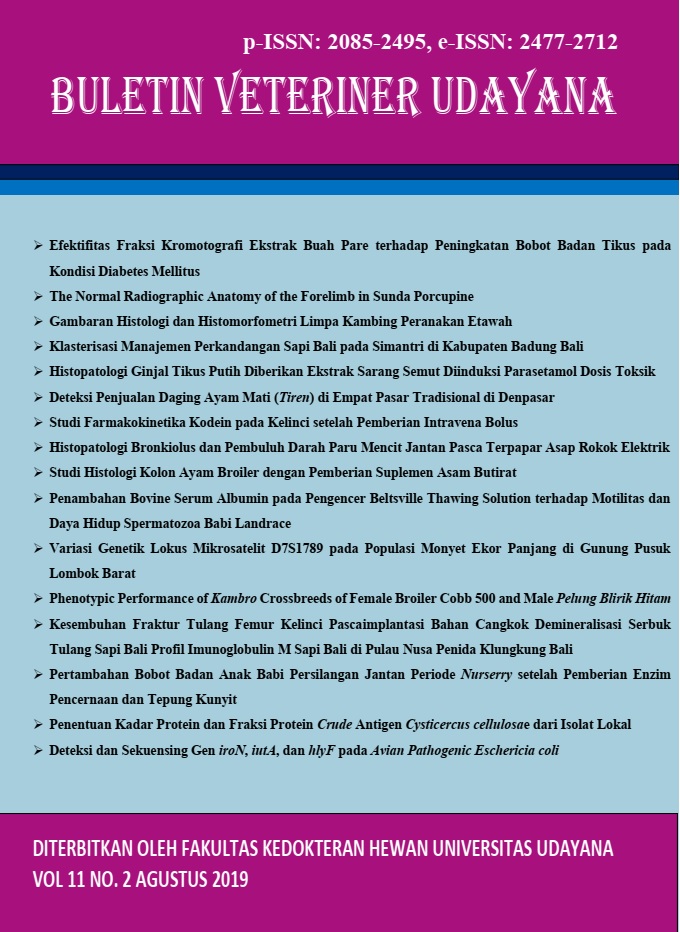DETECTION AND SEQUENCING GENES IRON, IUTA, AND HLYF IN AVIAN PATHOGENIC ESCHERICIA COLI
Abstract
Research has been carried out to detect pathogenic gene markers of Avian Pathogenic Eschericia coli (APEC) iroN, iutA, and hlyF in Escherichia coli bacteria isolated from organs of sick chickens in Bali, and to determine phylogenetic relationships between those marker genes in Bali and in the other countries in the world. Six isolates of E. coli bacteria with codes E2, E3, E7, E8, E9, and E10 were used in this study. The isolates were isolated from domestic chicken in 2018. All genes were detected using the Polymerase Chain Reaction (PCR) method. The genes of iroN, iutA, and hlyF could be detected from all isolates. Well readable sequence of iroN, hlyF, and iutA was 659 bp, 518 bp, and 250 bp, respectively. All three genes were homogenous. Phylogical analysis shows that all pathogenic markers share same cluster with the pathogenic E. coli from all countries in the world.
Downloads
References
Barus DO, Gelgel KTP, Suarjana IGK. 2013. Uji kepekaan bakteri Escherichia coli asal ayam pedaging terhadap antibiotik Doksisiklin, Gentamisin, dan Tiamfenikol. Indo. Med. Vet. 2(5): 538-545.
Denamur E, Matic I. 2006. Micro review: Evolution of mutation rates in bacteria. Mol. Microbiol. 60(4): 820-827.
Ewers C, Wilking H, Kiessling S, Antáo EM, Laturnus C, Diehl I, Glodde S, Homeier T, Böhnke U, Steinrück H, Philipp HC. 2007. Avian pathogenic, uropathogenic, and newborn meningitis-causing Escherichia coli: how closely related are they. Int. J. Med. Microbiol. 297: 163-176
Filho HCK, Carvalho D, Grassotti TT, Soares BD, Rossato JM, Cunha AC, Cavalli LS, Brito KCT, Brito BG. 2015. Avian pathogenic Escherichia coli – methods improved diagnosis. World’s Poult. Sci. J. 71: 249-258.
Hidayati SC, Darmawi, Rosmaidar, Armansyah T, Dewi M, Jamin F, Fakhrurrazi. 2016. Pertumbuhan Escherichia Coli yang diisolasi dari feses anak ayam broiler terhadap ekstrak daun salam (Syzygium polyanthum). J. Med. Vet. 10(2): 101-104.
Jamin F, Abrar M, Dewi M, Yanrivina SVS, Fakhrurrazi, Manaf ZF, Syafruddin. 2015. Infeksi bakteri Escherichia Coli pada anak ayam kampung (Gallus domesticus) di Pasar Lambaro Aceh Besar. J. Med. Vet. 9(1): 54-56.
Johnson TJ, Siek KE, Johnson SJ, Nolan LK. 2006. DNA sequence of a CoIV plasmid and prevalence of selected plasmid-encoded virulence genes among avian Escherichia coli strains. J. Bacteriol. 188(2): 745-758.
Johnson TJ, Wannemuehler Y, Doetkott C, Johnson SJ, Rosenberg SC, Nolan LK. 2008. Identification of minimal predictors of avian pathogenic Escherichia coli virulence for use as a rapid diagnostic tool. J. Clin. Microbiol. 46(12): 3987-3996.
Landman WJM, Eck JHH. 2016. The incidence and economic impact of the Escherichia coli peritonitis syndrome in Dutch poultry farming. Avian Pathol. 44(5): 370-378.
Lynne AM, Kariyawasam S, Wannemuehler Y, Johnson TJ, Johnson SJ, Sinha AS, Lynner DK, Moon HW, Jordan DW, Logue CM, Foley SL, Nolan LK. 2012. Recombinant iss as a Potential Vaccine for Avian Colibacillosis. Avian Disease. 56: 192-199
Mellata M. 2009. Full sequence and comparative analysis of the plasmid pAPEC-1 of avian pathogenic E. coli x7122 (O78:K80:H9). Plos One. 4(1): 1-12
Morales C, Lee MD, HofacreC, Maurer JJ. 2004. Detection of A novel virulence gene and a Salmonella virulence homologue among Escherichia coli isolated from broiler chickens. Foodborne Pathog. Dis. 1(3): 160-165.
Moulin-Schouleur M, Répérant M, Laurent S, Brée A, Mignon-Grasteau S, Germon P, Rasschaert D, Schouler C. 2007. Extraintestinal pathogenic Escherichia coli strains of avian and human origin: Link between phylogenetic relationships and common virulence patterns. J. Clin. Microbiol. 45: 3366-3376.
Nakazato G, Tatiana AC, Eliana GS, Brocchi M, Silveira WD. 2009. Virulence factors of avian pathogenic Escherichia coli (APEC). Pesq. Vet. Bras. 29(7): 479-486.
Radji M, Puspaningrum A, Sumiati A. 2010. Deteksi cepat bakteri Escherichia Coli dalam sampel air dengan metode Polymerase Chain Reaction menggunakan primer 16e1 dan 16e2. Makara. Sains. 14(1): 39-43.
Rodriguez KE, Giddings CW, Doetkott C, Johnson TJ, Nolan LK. 2005. Characterizing the APEC pathotype. Vet. Res. 36: 241–256.
Sudrajat D, Maria LR, Suhadi F. 2000. Deteksi cepat bakteri Escherichia coli enterohemoragik (Ehek) dengan metode PCR (Polymerase Chain Reaction). Risalah Pertemuan Ilmiah Penelitian dan Pengembangan Teknologi Isotop dan Radiasi. Jakarta
Sutrisno IK, Arundina I, Sosiawan A. 2013. Identifikasi bite marks dengan ekstraksi DNA metode chelex. Dental J. 46(2): 107-112.
Tabrah FL. 2011. Koch’s postulates, carnivorous cows, and tuberculosis today. Hawai. Med. J. 70(7): 144-148.
Tamura K, Stecher G, Peterson D, Filipski A, Kumar S. 2013. MEGA6: Molecular evolutionary genetics analysis version 6.0. Mol. Biol. Evol. 30: 2725-2729.
Vidotto M, Cacao CJM, Goes CR, Santos DS. 1991. Plasmid coding for aerobactin production and drug resistance is involved in virulence of Escherichia coli avian strains. J. Med. Biol. Res. 24: 677–685.
Walsh PS, Metzger DA, Higuchi. 1991. Chelex-100 as a medium for simple extraction of DNA for PCR based typing from forensic material. Biotechniques. 10: 506-513.
Weidosari E, Wahyuwardani S. 2015. Studi kasus penyakit ayam pedaging di Kabupaten Sukabumi dan Bogor. J. Ked. Hewan. 9(1): 9-13.
Wibowo MH, Wahyuni AETH. 2008. Studi patogenesitas Escherichia coli isolat unggas pada ayam pedaging umur 15 hari. J. Vet. 9(2): 87-93.





